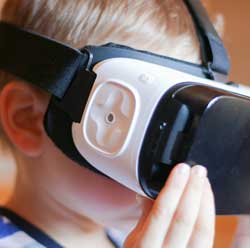How Parents Can Prepare For Virtual Reality Tech

by Jennifer Thayer
This has become the year of virtual reality, with countless headsets hitting the market at affordable prices and consumers waiting in line to try it out for themselves. And while many of those consumers may be adults, there are plenty of kids and teens waiting to get their hands on a VR headset of their very own. With the concept of immersive gaming experiences being the driving force behind VR sales, it’s no wonder that youth are getting in line to explore the virtual worlds of some of their favorite games. But what does this mean for parents exactly? It’s easy to simply take your child’s phone away or hide their X-Box controller when they’ve been grounded, but what should parents know about VR going forward?
Virtual Reality as a Learning Tool
With the virtual reality industry hinging on the concept of immersive mobile gaming, parents need to know what games are being targeted to their kids and teens. A large chunk of the virtual reality games on the market are for entertainment purposes, but there are also quite a few that are intended for educational use and some are even being used to help children with disabilities.
Virtual reality isn’t only for gaming, but is now becoming one of the most innovative tools in the world of art and design. With tools like Google’s upcoming Tilt Brush, children will be able to create 3D worlds of color and light, putting the days of crayons and Play-Doh far behind us. Children will also be experiencing bedtime stories in virtual reality, with Bedtime VR Stories from Samsung, which offers parents who travel often or are overseas the chance to share an immersive bedtime story with their child. Virtual reality is also becoming a tool to experience sports games and concerts, which could be good for children whose parents simply don’t have the time or money to pay for real-life experiences of that nature.
With VR tech leading in the way in entertainment content, it’s no wonder that it’s being applied to education as well. Students will now have the opportunity to go on virtual reality field trips, experience historical events first-hand, and even take a look at the human body at a microscopic level. The benefits of VR tech will no doubt encourage students to pursue STEM fields.
Affordability of Virtual Reality
Some parents might argue that virtual reality tech is simply too expensive or simply not accessible yet, but that isn’t the case. With the popularity of VR growing, some companies are jumping on the bandwagon and are providing easy, accessible, and affordable options, such as Samsung’s Gear VR that provides a state-of-the-art virtual reality experience when paired with any Samsung Galaxy mobile device. The majority of the Galaxy devices are powered by Snapdragon chips, which happen to be some of the fastest mobile processors on the market. Not only do these processors deliver up to a 40% faster performance rate than previous generations, but they even produce 4K Ultra HD resolution. These features create a smoother experience so you truly feel how lifelike the technology is.
Entertainment
VR tech has yet to be applied to streaming and binge-watching television series and movies, but some companies have begun creating bite-sized VR content intended for entertainment purposes, such as Sony Pictures’ “Ghostbusters: Dimensions“, a multi-player experience into the world of the movie franchise. Critics of VR have said that the applications to “binge-watching” are limited, which is a good thing for parents, since some concerns have been about VR tech “turning kids into zombies” or “hurting their eyes”. VR in small doses won’t do any damage, especially when your child isn’t zoning out on seasons of “The Amazing World of Gumball”.
Ultimately, parents need to simply keep an eye on the content their children are consuming, whether it’s video games, movies, or TV shows. Virtual reality will be bringing a lot of great new interactive content for kids, such as interactive field trips and in-depth looks at their favorite fantasy worlds. All in all, it’s up to the parent to decide what is best for their child, but it’s always a good idea to be informed of what is coming out in the technology sphere.
About the Author: Jennifer Thayer is a technology writer from Southern California. She is passionate about exploring new ways technology can be used to make day-to-day tasks easier. Follow her on Twitter
Image Credit: Andri Koolme




